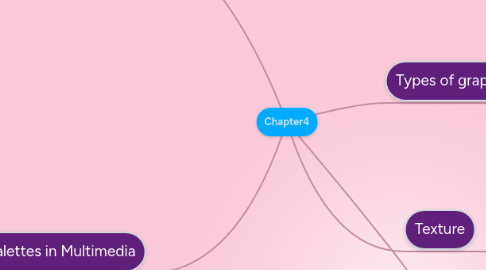
1. Color and Palettes in Multimedia
1.1. Understanding natural light and color models
1.1.1. Additive color
1.1.1.1. create by colored light sources in three primary colors-red green blue
1.1.1.2. Tv and computer use this method
1.1.2. Subtractive color
1.1.2.1. created by combining colored media such as paint or ink
1.1.2.2. Colored media absorb some part of spectrum of light and reflect the others back to the eye
1.1.2.3. Use to create color in printing
1.2. Dithering
1.2.1. 24bits,16million colour depth
1.2.2. If display system limited less than16million colors,the images must transform for display in lesser color environment.
1.2.3. using a algorithms
2. 3D drawing
2.1. 3D animation tools
2.2. Features of 3-Dapplication
2.2.1. Modeling
2.2.1.1. 3D spaces
2.2.2. Extrusion
2.2.2.1. The shape of plane surface extends some distance
2.2.3. Lathing
2.2.3.1. profile shape rotated around a defined axis
3. Images file types used in multimedia
3.1. Macintosh formats
3.1.1. PICT
3.2. Windows formats
3.2.1. DIB,known as BMP
3.3. Cross-platform formats
3.3.1. JPEG,GIF,PNG
4. Types of graphic
4.1. Bitmap graphic
4.1.1. Advantages
4.1.1.1. different textures
4.1.2. Disadvantages
4.1.2.1. Large file sizes
4.1.2.2. Not easy to make modifications to objects
4.1.2.3. Resizing a bit mapped images requiring either duplicating pixels
4.1.2.4. "blocky"when size increased
4.2. Vector graphic
4.2.1. Vector-drawn graphics
4.2.1.1. Applications of vectors-drawn object
4.2.1.2. How vector-drawn images work
4.2.1.3. Vector-drawn images versus bitmaps
4.2.2. Advantage
4.2.2.1. use less memory space
4.2.2.2. download faster,when use animation,draw faster than bitmaps
4.2.2.3. easily scalable without loss of resolution
4.2.2.4. easy to edit the drawings
4.2.3. Disadvantage
4.2.3.1. cannot have texture
4.2.3.2. cannot use for photorealistic images
4.3. How vector-drawn images work
4.3.1. describe by the location of its two endpoints
4.3.2. make use of Cartesian coordinates
4.3.3. Cartesian coordinates are number describe a point in two-or-three -dimensional

